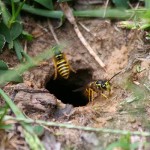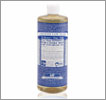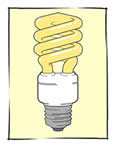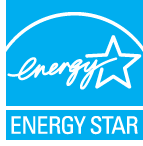 I’m not someone who delights in killing pests, and I don’t often advocate for their demise. In fact, I usually do my best to avoid killing them (e.g., if an indoor spider gets too close for comfort, I usually capture it in a jar and release it outside). However, I recently had to make an exception to my pacifist policy, when I noticed that yellow jackets had built a ground nest right next to the front door of our house. It was an underground nest in a flower bed. There were so many yellow jackets coming and going from the nest throughout the day that we were scared to keep our front door open for very long, and I worried that our dog would inadvertently step on the entry to the nest and get swarmed and attacked. Furthermore, I learned that some yellow jackets raid honeybee hives to steal their honey, and they kill honeybees in the process. This was a sufficiently good reason to get rid of the ground-nest jackets, in my opinion. One of our neighbors has a honeybee hive, so it felt like getting rid of these yellow jackets was a just and neighborly thing to do. (Honeybees are suffering from a Colony Collapse Disorder. For info about it, click here. Note: If you have a problem with a swarm, nest, or hive, check out online photos of bees, yellow jackets, hornets, etc. to make sure you know which of these you’re dealing with. Honeybees and other pollinators are extremely important, and they almost never sting; please don’t kill them.)
I’m not someone who delights in killing pests, and I don’t often advocate for their demise. In fact, I usually do my best to avoid killing them (e.g., if an indoor spider gets too close for comfort, I usually capture it in a jar and release it outside). However, I recently had to make an exception to my pacifist policy, when I noticed that yellow jackets had built a ground nest right next to the front door of our house. It was an underground nest in a flower bed. There were so many yellow jackets coming and going from the nest throughout the day that we were scared to keep our front door open for very long, and I worried that our dog would inadvertently step on the entry to the nest and get swarmed and attacked. Furthermore, I learned that some yellow jackets raid honeybee hives to steal their honey, and they kill honeybees in the process. This was a sufficiently good reason to get rid of the ground-nest jackets, in my opinion. One of our neighbors has a honeybee hive, so it felt like getting rid of these yellow jackets was a just and neighborly thing to do. (Honeybees are suffering from a Colony Collapse Disorder. For info about it, click here. Note: If you have a problem with a swarm, nest, or hive, check out online photos of bees, yellow jackets, hornets, etc. to make sure you know which of these you’re dealing with. Honeybees and other pollinators are extremely important, and they almost never sting; please don’t kill them.)
Update: I have also recently learned some of the ways that wasps, including yellow jackets, also have ecological value and provide ecological balance; for example, they eat aphids (which are the scourge of many gardens). And I’ve learned that paper wasps look like yellow jackets, but paper wasps build honeycomb paper-like nests (under roof eaves or elsewhere), and they are not aggressive or interested in humans or human foods (e.g., meat and sugary foods) like yellow jackets. So I leave the paper wasps and their nests alone. In fact, they built one next to our back door, and they never bothered us at all or even tried to come inside.
Anyway, back to our ground nest problem: I didn’t want to use toxic insecticides, which could kill the flowers in our garden and poison our dog and the honeybees, along with the soil and groundwater around our house. So, thinking we were being clever, my husband and I tried putting the garden hose down the nest entry hole and flushing out the nest with water. This scheme did not work. We tried it a few evenings in a row, and the tenacious buggers would shoot out of the nest alive (seemingly unfazed by the water) and quickly rebuild a new entry hole. One evening, they went into attack mode and my husband got stung. They won these battles, but we were determined to outsmart them and win the war — without resorting to the use of Raid, professional chemical insecticides, gasoline, or any of the other toxic and hazardous substances that are commonly suggested.
 So I started researching other non-insecticide solutions. Through my reading, I learned that mint oil can kill almost any insect, and that yellow jackets also don’t like soapy or boiling water… We happened to have a quart-size container of Dr. Bronner’s “magic” organic peppermint castile liquid soap in the house. The bottle was only half full, so we filled the rest of it up with water to make it a 50% diluted quart. Then we waited ‘til it was almost dark outside (this is the only time you should ever deal with yellow jackets, as they’re all inside the nest and inactive at night). We poured the quart down the nest’s entry hole (it’s best to do this with an extension device, like a hose or a gas can or watering can, to keep your body further from the nest opening — and you should also wear protective clothing). We immediately followed that up by pouring in a kettle full of boiling hot water, which washed the mint oil further down into the nest. We didn’t see a single yellow jacket emerge from the nest that night, and we haven’t seen any around here since. It worked!
So I started researching other non-insecticide solutions. Through my reading, I learned that mint oil can kill almost any insect, and that yellow jackets also don’t like soapy or boiling water… We happened to have a quart-size container of Dr. Bronner’s “magic” organic peppermint castile liquid soap in the house. The bottle was only half full, so we filled the rest of it up with water to make it a 50% diluted quart. Then we waited ‘til it was almost dark outside (this is the only time you should ever deal with yellow jackets, as they’re all inside the nest and inactive at night). We poured the quart down the nest’s entry hole (it’s best to do this with an extension device, like a hose or a gas can or watering can, to keep your body further from the nest opening — and you should also wear protective clothing). We immediately followed that up by pouring in a kettle full of boiling hot water, which washed the mint oil further down into the nest. We didn’t see a single yellow jacket emerge from the nest that night, and we haven’t seen any around here since. It worked!
RECIPE
1/2 quart (2 cups) Dr. Bronner’s organic peppermint castile soap, diluted/mixed with
1/2 quart (2 cups) water [poured into the nest via a hose or watering can with a long nozzle, at dusk or at night]
Followed by 1 tea-kettle full (approx. 1 quart or 4 cups) of boiling water
[NOTE: While this solution worked for this ground nest, it probably is NOT appropriate—and could be a dangerous method to try—for other scenarios, e.g., nests in the walls of your house, where you cannot find the exact entry spot. For those types of situations, try using Rescue traps or making a homemade soda-bottle trap instead.]
Dr. Bronner’s entertaining, pontificating text-filled label (I recommend reading all of the fine print if you haven’t before) states that the soap is good for 18 different uses: from washing pets and babies to washing dentures and cars. Yellow jacket / insect eradication isn’t one of the listed uses, but it seems that it should be. Soon I’m going to experiment with using the stuff to repel mosquitos, get rid of ants, and keep fleas and other bugs off of the dog.
[July 2011 Update: For helpful advice on a bunch of yellow jacket (and other insect control) solutions that have worked for other people, take a look at the Comments on the newer version of this post, which is on MotherEarthNews.com.]
P.S. Check out the Dr. Bronner company’s good work on social and environmental issues (e.g., fair trade, truly organic ingredients, employee salaries and benefits, charitable donations, etc.). And if you’re curious about the eccentric Dr. Bronner’s life, rent the fascinating documentary Dr. Bronner’s Magic Soapbox.
July 6, 2009


 I’m not someone who delights in killing pests, and I don’t often advocate for their demise. In fact, I usually do my best to avoid killing them (e.g., if an indoor spider gets too close for comfort, I usually capture it in a jar and release it outside). However, I recently had to make an exception to my pacifist policy, when I noticed that yellow jackets had built a ground nest right next to the front door of our house. It was an underground nest in a flower bed. There were so many yellow jackets coming and going from the nest throughout the day that we were scared to keep our front door open for very long, and I worried that our dog would inadvertently step on the entry to the nest and get swarmed and attacked. Furthermore, I learned that some yellow jackets raid honeybee hives to steal their honey, and they kill honeybees in the process. This was a sufficiently good reason to get rid of the ground-nest jackets, in my opinion. One of our neighbors has a honeybee hive, so it felt like getting rid of these yellow jackets was a just and neighborly thing to do. (Honeybees are suffering from a Colony Collapse Disorder. For info about it,
I’m not someone who delights in killing pests, and I don’t often advocate for their demise. In fact, I usually do my best to avoid killing them (e.g., if an indoor spider gets too close for comfort, I usually capture it in a jar and release it outside). However, I recently had to make an exception to my pacifist policy, when I noticed that yellow jackets had built a ground nest right next to the front door of our house. It was an underground nest in a flower bed. There were so many yellow jackets coming and going from the nest throughout the day that we were scared to keep our front door open for very long, and I worried that our dog would inadvertently step on the entry to the nest and get swarmed and attacked. Furthermore, I learned that some yellow jackets raid honeybee hives to steal their honey, and they kill honeybees in the process. This was a sufficiently good reason to get rid of the ground-nest jackets, in my opinion. One of our neighbors has a honeybee hive, so it felt like getting rid of these yellow jackets was a just and neighborly thing to do. (Honeybees are suffering from a Colony Collapse Disorder. For info about it, 

